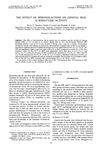Peripheral Androgens And The Role Of Androstanediol Glucuronide
May 1986
in “
Clinics in endocrinology and metabolism
”

TLDR Androstanediol glucuronide is a reliable marker for hirsutism in women.
The document discussed the metabolism of androgens in women, focusing on androstanediol glucuronide (3aAdG) as a marker for peripheral androgen formation and hirsutism. It found that most circulating testosterone in women came from androstenedione conversion. Elevated 3aAdG levels were observed in hirsute women, making it a reliable marker for hirsutism, unlike plasma DHT. Studies with 54 women (30 idiopathic hirsutism, 24 PCO) supported 3aAdG as an indicator of peripheral androgen action. The study showed significant 3aAdG production in hirsute women with PCOS and highlighted the role of peripheral tissues, particularly skin, in androgen metabolism. It also noted that 5α-reductase activity (5αRA) was crucial and could be inhibited by steroids like spironolactone, though this did not reduce serum 3aAdG levels. The research contributed to understanding the endocrine control of male phenotypic development and conditions like idiopathic hirsutism.

